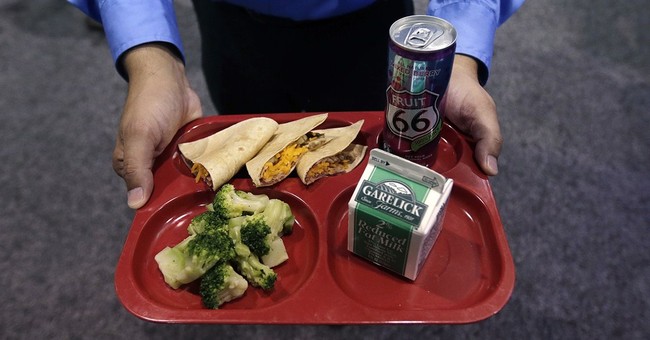
Posted on 01/10/2018 9:41:52 AM PST by Kaslin

For years after Michelle Obama’s ironically named Healthy, Hunger-Free Kids Act of 2010, students at Penn-Trafford High School in Harrison City, Pennsylvania staged an accidental trash can rebellion. As in many districts, waste management companies were the only winners as students dumped lunch into the garbage.
For this school year, Penn-Trafford High School instead tossed Mrs. Obama’s school lunch plan and now President Trump is doing the same on a national scale.
As with any policy created by coercive utopians to control personal choices, nothing about the Obama plan made sense. Kids, parents and school districts hated it, and its restrictions harmed children it was ostensibly designed to help.
The Act’s directives called for lowering calories, portions and sodium through whole grains and non-fat milk and increasing fresh veggies and fruit — a one size fits all approach that resulted in the first decrease in the $13.6 billion National School Lunch Program participation in decades. Although the Obama administration never published the number of schools dropping the program, the media was full of such reports and social media exploded with memes, tweets and videos made by disgusted, hungry children.
It ignored schools’ regional and cultural differences. Asian students didn’t like brown rice and Hispanic children wanted normal tortillas that didn’t crack when rolled. It set the same calorie limits for an 85 pound gymnast and a 250 pound linebacker. Its sodium restrictions were too low for athletes or a child in Texas walking home in June. The student in East L.A. does not necessarily share food favorites with a kid in Manhattan or one in rural Tennessee. Cafeteria creativity and local food preferences flew out the window with its mandates.
The School Nutrition Association (SNA) representing school nutrition professionals has repeatedly expressed concern that “overly prescriptive regulations” resulted in kids throwing lunches away while districts struggled financially with increased compliance costs exceeding federal subsidies. The SNA CEO Patricia Montague recently noted, “SNA is appreciative of Secretary Perdue’s support of … flexibility to serve healthy meals.” Studies, including one by the University of Vermont in 2015, showed selection does not equal consumption as students put more fruit and vegetables on their trays, but less in their mouths.
Want school children to eat more broccoli? Give them a salt shaker and a small pat of butter. One could tell a child her plain spinach is full of pixie dust or his skinless chicken has super powers but they still won’t eat it. As Secretary Perdue has quipped, “Hungry children cannot learn and trash cans don’t need nourishment.”
Of great concern to school nutritionists are the more than 21 million children who receive free or subsided lunch each school day. For many, this meal is their main source of daily calories and nutrition. New York City admitted when it first implemented the program, its meals fell below minimum calorie guidelines and created nutritional deficits. For a child dependent on these calories, restrictions and edibility issues render the trash can a deadly enemy.
Mrs. Obama claimed these changes were designed to fight obesity, but where do most kids get their daily calories and whose fault is it if they are overweight?
Based on a simple calculation of three meals a day, children eat roughly 915 meals “at home” annually, and only 180 at school (breakfast programs and parent-packed lunches not considered.) According to the Center for Disease Control, 34 percent of children eat fast food on any given day. In 2016, consumers spent more at restaurants ($54 billion) than in grocery stores ($52 billion.) And statistically, a reduced socio-economic status is the greatest driver of childhood obesity, not school lunches.
Schools are utilizing healthy alternatives on their own and in greater numbers. Salad bars are becoming more popular and local “farm to school” programs are now operating in nearly 43,000 cafeterias. As kids clamor for real chocolate milk rather than cocoa-flavored water, some districts are throwing caution to the wind and serving one percent again instead of non-fat.
The Healthy, Hunger-Free Kids Act was not designed by kids, nor does it make anyone hunger-free. The Trump administration under Agriculture Secretary Sonny Perdue has already rolled back a few of the more ridiculous restrictions and is looking to a full overhaul by the beginning of the next school year. With input from varying school districts, the SNA - and hopefully parents and children - cafeteria budgets can be made whole and children can start enjoying their lunches again.
The students at Penn Trafford were not elected, but then, neither was Michelle Obama. But President Trump was. A revised school lunch program can also serve up a lesson about how a democracy is supposed to work and whose choices really matter.
pressured each registering and re-registering parent to sign up for free lunches. They got money for the food <<
Not only that...the more free lunches (i.e. poor)....the lower the bar for state wide tests...

Disclaimer: Opinions posted on Free Republic are those of the individual posters and do not necessarily represent the opinion of Free Republic or its management. All materials posted herein are protected by copyright law and the exemption for fair use of copyrighted works.